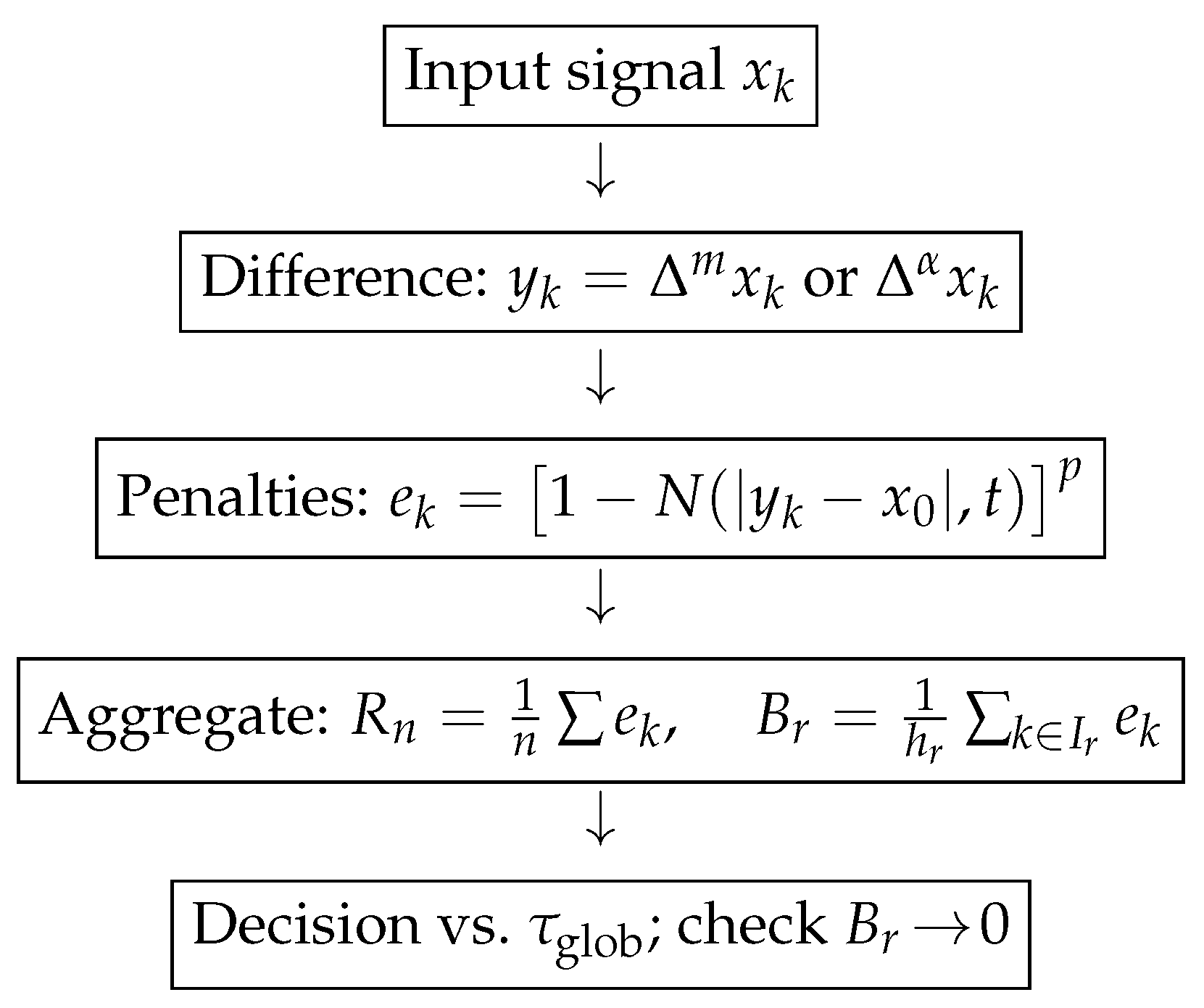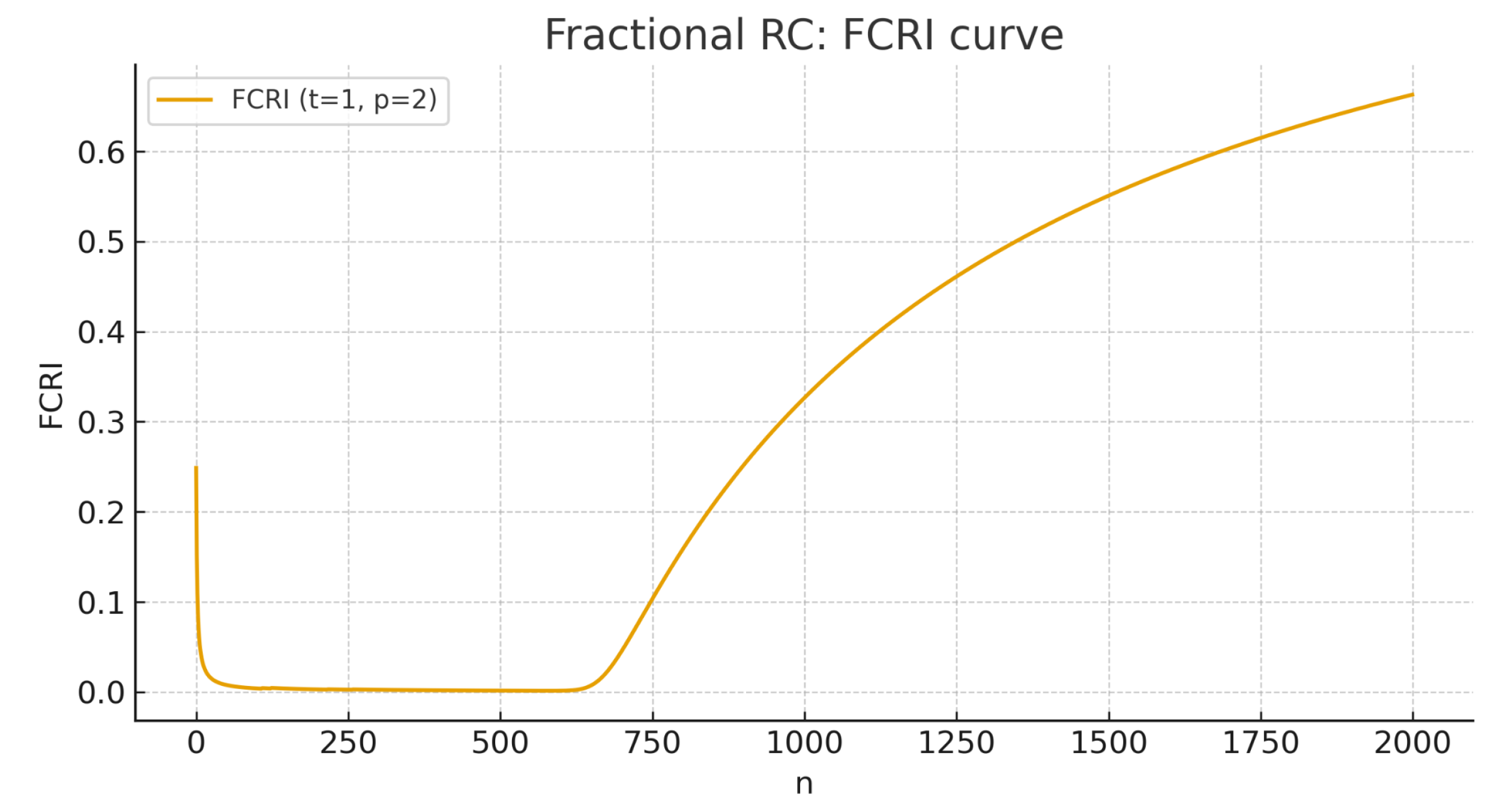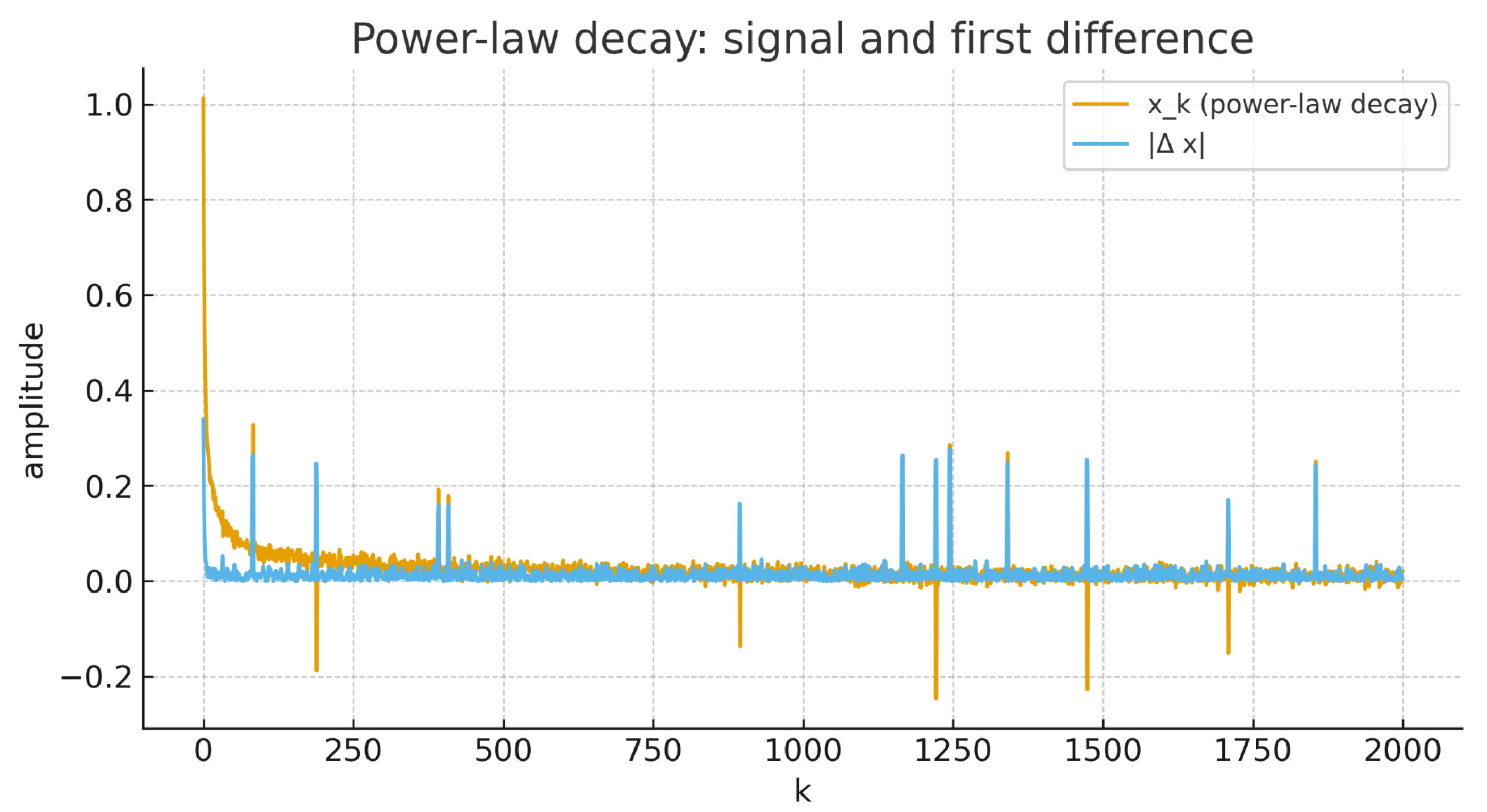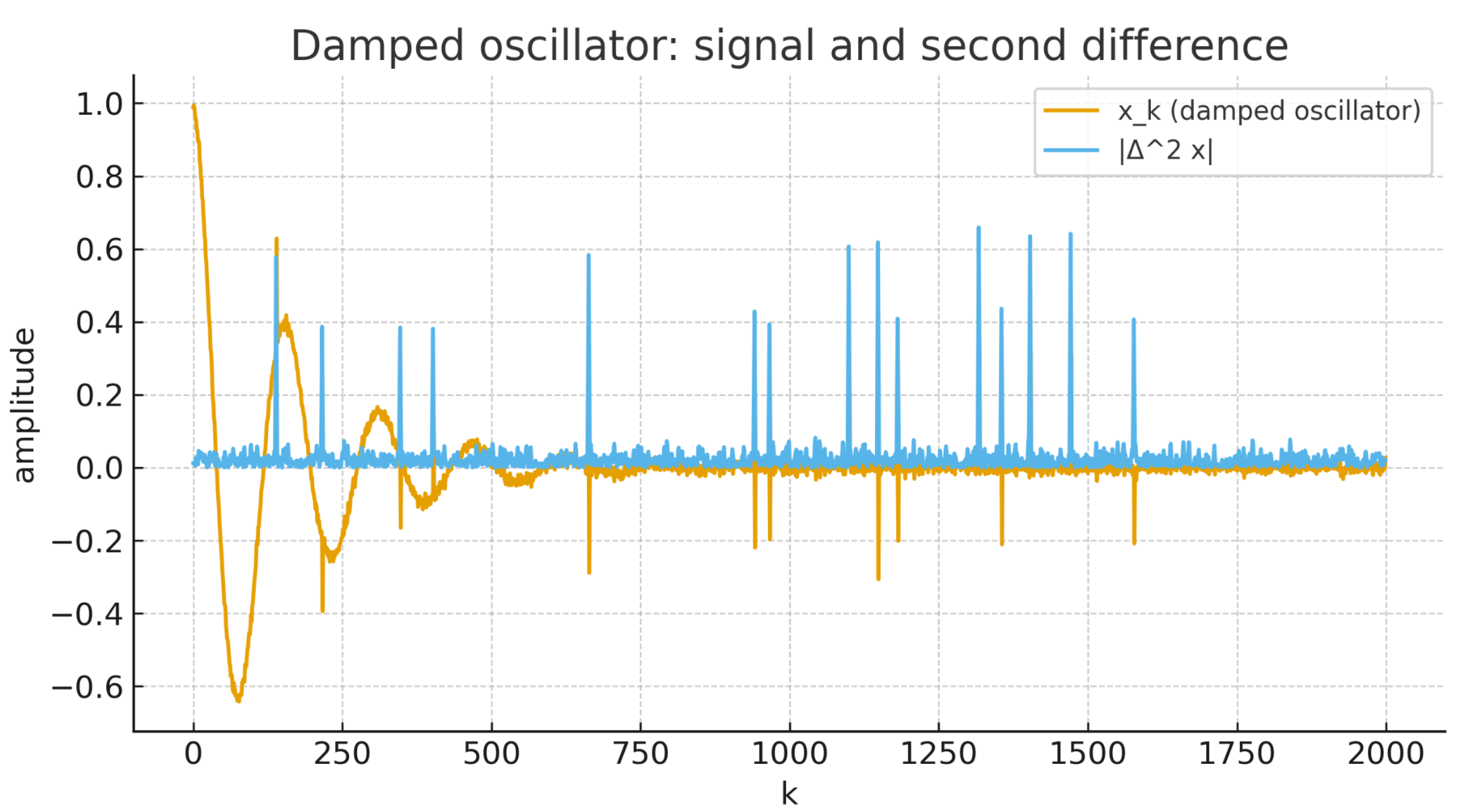1. Introduction
Discrete operators of integer and fractional order have become central to the analysis of engineering data in which memory, heredity, and irregular sampling are intrinsic. In sequence spaces, the classical
mth forward difference
acts as a local regularity detector and smoothing filter, while its fractional Grünwald–Letnikov (GL) counterpart
incorporates long-range dependence via slowly decaying binomial weights, providing a tunable bridge between differentiation and averaging [
1,
2,
3]. From an engineering perspective, signals with long memory and impulsive disruptions are well documented in robust filtering and nondestructive evaluation:
-stable regimes motivate non-Gaussian filtering structures that explicitly accommodate heavy tails [
4], while fuzzy metrics and inference have been shown effective on eddy-current measurements for classifying stress states and structural anomalies in uncertain environments [
5]. These observations motivate our choice of GL fractional differences (to encode memory and burst tolerance) and fuzzy-paranormed proximity (to model resolution-dependent uncertainty) in a unified convergence framework. When measurements are imprecise or bursty—a common feature in electrical/thermal networks, mechanics, biology, and computer systems—rigid norm topologies may misrepresent proximity; this motivates convergence notions that (i) tolerate sparse outliers and (ii) quantify closeness at multiple resolutions.
A density-based idea that addresses (i) is statistical convergence—introduced independently by Fast and Steinhaus—where the exceptional indices have natural density zero [
6,
7]. The concept interacts fruitfully with summability theory (e.g., strong Cesàro means) and lacunary methods [
8,
9,
10]. In parallel, the study of difference sequence spaces—initiated by Kızmaz and extended to higher orders—has supplied a discrete calculus for filtering, spike detection, and operator-theoretic investigations [
11,
12]. These strands suggest combining difference filters with density-based limits. Recent studies have further connected fuzzy metrics and statistical-type limits to practical decision problems, including fp-space convergence tools tailored for GL differences and diagnostics,
-statistical and ideal convergence in fp settings with applied calibration, and lacunary/ideal schemes for discrete-time stability under missing measurements [
13,
14,
15,
16]. Our work differs by placing integer and fractional difference operators at the center of a unified, density-aware convergence framework in fp spaces and by developing engineering-style diagnostics (via Cesàro decay of residuals) with explicit operator continuity and lifting from
to
(see Lemma 1 and Proposition 1).
To address (ii), fuzzy norm-like structures replace a single-valued norm by a membership map
depending on a resolution parameter
, thus capturing imprecision without abandoning linear structure. We emphasize why a fuzzy paranorm (rather than a single quasi-norm or a crisp fuzzy norm) is adopted: the
t-norm
L supplies the lower-triangular control actually used in our proofs, while the
t-conorm
R provides an upper-envelope compatible with common aggregation semantics. In applications,
L captures robust conjunction at fixed resolution
t and yields tractable levelwise estimates;
R is retained for completeness and modeling fidelity, although our theorems invoke only the
L-bound. Fuzzy (para)normed models formalize this idea and recover classical results when
N is induced by a usual norm (e.g.,
) [
17,
18]. This makes them natural hosts for uncertainty-aware convergence.
Fractional differences enter our framework on equal footing with
. GL discretizations place initial data transparently and admit a delta/nabla duality, together with a
Q-operator that transfers statements between left/right forms and clarifies the link with discrete Riemann–Liouville calculus [
2,
19,
20]. For clarity and concreteness, we develop the main results for the classical operator
and record the fractional lift to
in the preliminaries; the proofs carry over by replacing finite differences with the absolutely summable GL binomial kernel.
1.1. Contributions and Relation to Prior Work
New contributions in this paper are as follows: (i) Uniqueness of fp- statistical limits via a levelwise-to-fuzzy lifting argument in fp spaces. (ii) Equivalence fp- statistical convergence ⟺ fp-strong p-Cesàro (with explicit assumptions on , completeness where invoked, and uniform -level compatibility). (iii) Lacunary fp- statistical convergence ⟺ blockwise strong p-Cesàro under . (iv) A density-based decomposition into a classically convergent part plus an fp-null remainder. (v) Continuity of in the fp topology via the GL binomial kernel, together with nabla/delta transfer through the discrete Q-operator (Lemma 1, Proposition 1).
Extensions/Adaptations: We extend classical statistical/summability principles [
8,
9] and difference-sequence ideas [
11,
12] to the fuzzy-paranormed and fractional-difference setting, clarifying which fuzzy assumptions are essential (use of
t-norm only) and how GL kernels enable the fractional lift. In contrast to [
13,
14,
15,
16], our focus is on a unifying difference-based fp framework with an engineering-facing diagnostic (FCRI) and quantitative calibration against robust baselines, including
-stable filtering [
4] and fuzzy-inference applications on eddy-current data [
5].
1.2. Positioning Relative to Recent Works
Unlike the recent fp/fuzzy-normed results in [
13,
14,
15,
16], which emphasize (variants of) statistical or ideal convergence predominantly in fuzzy normed settings or with application-specific stability goals, our contribution is to introduce a unified, difference-operator-centered framework in fuzzy-paranormed spaces that (i) treats integer and fractional differences on equal footing; (ii) lifts to the Grünwald–Letnikov regime via an explicit
-kernel continuity route (Lemma 1, Proposition 1); and (iii) develops an engineering-facing diagnostic (the fuzzy-Cesàro residual index, FCRI) with sensitivity-based calibration across
and quantitative baselines (median/M-estimators,
trend filtering, Gaussian Kalman filtering, and an
-stable filtering structure). This distinction is reflected in our equivalence theorems between fp-
statistical convergence and fp-strong
p-Cesàro modes (Theorem 2), the lacunary/blockwise counterparts (Theorem 4), and the density-based decomposition (Theorem 3), together with a fractional lift (Corollary 1).
1.3. Organization
Section 2 recalls fuzzy paranorms (with a brief rationale on
t-norm/
t-conorm), difference sequence spaces, statistical/lacunary convergence, and GL-type fractional differences, including an
kernel lemma.
Section 3 gives uniqueness, equivalence with strong
p-Cesàro, the density-based decomposition, and lacunary counterparts, together with assumptions stated explicitly; a remark outlines the
extension.
Section 4 reports engineering-style experiments, sensitivity-based calibration of
, and comparisons with robust baselines. We conclude with practical guidance and open problems.
3. Main Results
Throughout this section, we work under (H1)–(H5) in
Section 2.1. We use the fp-
statistical, lacunary statistical, and strong
p-Cesàro notions (Definitions 13–16). The proofs rely on the finite-difference identity (
1) and the GL form (
2); the fractional lift uses the
kernel and continuity facts (
3) and (
4) and Proposition 1. Unless otherwise stated, we fix
,
, and
; the lacunary scheme
and fp-
-boundedness are as in Definitions 7 and 15.
Theorem 1.
Let be a fuzzy-paranormed space, and let be a sequence in X that is fp--statistically convergent to both and . Then .
Proof. Assume that
Fix arbitrary
and
. Since the t-norm
L is (jointly) continuous and
, there exists
such that
Define the index sets
By fp-
-statistical convergence to
and
,
Let
. Then also
Hence for all
(i.e., for almost all
k) we have
Write
Using the fuzzy paranorm axioms, by (FP3) (triangle-type inequality with t-norm
L) applied with
and
, and by (FP2) (
), we obtain
Since
and
are arbitrary, it follows that
By the axioms of a fuzzy paranorm (separation),
for all
implies
. Hence
, i.e.,
. □
Theorem 2.
Assume (H1)–(H3). Let be a fuzzy-paranormed space and let be a sequence in X with a fixed resolution and exponent .
- 1.
If x is fp--strongly p-Cesàro summable to , then x is fp--statistically convergent to .
- 2.
If x is fp--statistically convergent to , then x is fp--strongly p-Cesàro summable to .
Remark 4
(Assumptions for Theorem 2). The range guarantees levelwise subadditivity (Minkowski) needed in the Cesàro-to-statistical direction and is standard in summability theory; for , one may retain one-sided implications under extra boundedness, but we do not use them here. Completeness is only invoked through (H2) where limit passages are stated levelwise.
Proof. We prove the equivalence in two parts. (i) fp-
-Strongly
p-Cesàro Summability ⟹ fp-
-Statistical Convergence: Assume that
x is fp-
-strongly
p-Cesàro summable to
; that is, for every fixed
and
,
Let
be arbitrary. Since the function
is continuous and strictly increasing on
, choose
(the inverse of
on
) so that
Thus, whenever
we have
Define the set
Then, we have the estimate:
Dividing both sides by
n yields
Taking the limit as
and using the assumption that the Cesàro mean tends to 0, we obtain
Since
is arbitrary, it follows that
Thus, by the definition of fp-
-statistical convergence, we have
which means that
x is fp-
-statistically convergent to
.
(ii) fp-
-Statistical Convergence ⟹ fp-
-Strongly
p-Cesàro Summability: Now assume that
x is fp-
-statistically convergent to
; that is, for every
and every fixed
,
For a given
, decompose the index set
into two parts:
and its complement,
Then, the Cesàro mean can be split as
For
, using
we have
so that
For
, we have
Since
, it follows that
Thus, we obtain
Taking the limit superior as
and noting that
by the assumption of fp-
-statistical convergence, we deduce
Since
is arbitrary, letting
implies
Thus,
x is fp-
-strongly
p-Cesàro summable to
.
Combining parts (i) and (ii), we conclude that the two modes of convergence are equivalent. □
Theorem 3.
Assume (H1). Let be a total fuzzy-paranormed space and suppose -fp(st)-. Then there exist sequences with , (classical convergence) and z fp--statistically null.
Remark 5
(Discrete spatial lattices). An analogue of Theorem 3 holds on by replacing natural density with upper Banach density on boxes and using multi-index finite differences (or GL convolutions with kernels). The proof follows verbatim: the “bad” set has vanishing upper Banach density, and the finite support/finite-band (or ) property keeps the exceptional region’s m-neighborhood negligible in density.
Proof. By fp-statistical convergence, there exists with natural density 1 such that as along for each fixed . Define if and otherwise, and set . Then in the ordinary sense. Since has density 0, the finite-band dependency of implies only when k lies in the m-neighborhood of S, which still has density 0. Hence -fp(st)-. □
Theorem 4.
Assume (H1) and for the lacunary sequence , whereLet be a fuzzy-paranormed space. Then: - (i)
If x is fp--strongly p-Cesàro summable to , i.e.,then x is fp-lacunary -statistically convergent to , i.e.,for every . In other words, - (ii)
If x is fp-lacunary -statistically convergent to , then x is fp--strongly p-Cesàro summable to . In fact, the two lacunary notions are equivalent.
Proof. (i) Assume that
x is fp-strongly
p-Cesàro summable to
; i.e.,
Fix
and let
be arbitrary. Choose
with
so that whenever
we have
Define
Then,
Since the left-hand side tends to zero as
, it follows that
This is equivalent to the statement that
i.e.,
x is fp-lacunary
-statistically convergent to
.(ii) Conversely, assume that
x is fp-lacunary
-statistically convergent to
; that is,
Since
, we have
where the first term corresponds to indices where
is significantly below 1 and the second term accounts for the remaining indices (which, by fp-lacunary
-statistical convergence, contribute negligibly). Taking the limit as
, and since
, we deduce
Thus,
x is fp-
-strongly
p-Cesàro summable to
. □
Fractional Extensions
Corollary 1
(Fractional lift of the main theorems).
Let . Replacing by in Theorems 1–4 yields the same conclusions under the same boundedness/lacunarity hypotheses. This follows from the absolute summability of GL binomial weights (3) and (4) and the fp-continuity of (Proposition 1), which allow the integer-order arguments to lift verbatim.
Remark 6
(Nabla/delta duality). All statements transfer verbatim between nabla-left and delta-right GL differences via the discrete Q-operator; this also aligns the GL and discrete Riemann–Liouville viewpoints.
4. Examples and Applications
Unless stated otherwise, the examples and numerical analyses in this section are developed under the standing assumptions listed in
Section 2.1. Accordingly, we work in a total fuzzy-paranormed space
, where
for all
implies
. When an upper control for summations is needed, we use the product
t-norm and the probabilistic
t-conorm (
,
), which correspond to the numerical model
Alternatively, weaker statements may rely only on -bounded penalties and the time-splitting condition . Both finite differences and the Grünwald–Letnikov operator (with absolutely summable weights ) are used throughout the examples that follow.
4.1. Algorithmic Implementation and Diagnostic Pipeline
We summarize a reference implementation for fp-statistical, fp-lacunary, strong p-Cesàro, and the fuzzy-Cesàro residual index (FCRI).
Convention: Throughout Algorithm 1, we write , where uses an integer order and a fractional order .
| Algorithm 1: FCRI computation and decision. |
Inputs: signal x[1…n]; operator in {Delta^m (integer m), Delta^\alpha (fractional \alpha)}; parameters (t>0, p>=1); optional lacunary schedule Theta=(k_r) with blocks I_r; decision threshold tau_glob>0. Step 1: Compute difference residuals: r_k :=|(Delta^{mode} x)_k - x0| (with x0 typically 0). Step 2: Membership penalties: e_k := [ 1 - N(r_k, t) ]^p, where N(u,t)=t/(t+|u|). Step 3: Global index: R_n^{(mode,p)}(t;x0) := (1/n) * sum_{k=1}^n e_k. Step 4: (optional lacunary): For each block I_r, compute B_r := (1/|I_r|)*sum_{k in I_r} e_k. Decision: Global pass if R_n^{(mode,p)} <= tau_glob. Lacunary pass if B_r -> 0 as r->infty. Outputs: R_n^{(mode,p)}, {B_r} (optional), pass/fail. |
Complexity: The pipeline is
for fixed
m; for GL
, we use the finite left-sided form (
2), remaining
with a small constant (
Figure 1).
4.2. Theory-Driven Illustrative Examples
4.2.1. Baseline Decay Under First Differences
Example 1
(Harmonic tail).
Let . For (Kızmaz [11]), , so for every fixed , and 4.2.2. Isolated Spikes at Lacunary Indices
Example 2
(Single spike per lacunary block).
Let with , , . DefineThen in each there is exactly one “bad” index for which , hence and fp–Δ–lacunary statistical convergence holds. Since , the block mean as well.
4.2.3. Sparse Anomalies at Zero Density and Higher Order
Example 3
(Squares with second differences). Let if k is a perfect square, and otherwise. Since we have iff at least one of k, , or is a square. Squares have natural density 0, hence the set has vanishing density. Thus, -fp(st)-. As , the strong Cesàro means also vanish blockwise (see Theorem 4).
4.2.4. Absolutely Summable Second Differences
Example 4
(
-controlled differences).
For ,Hence and the fuzzy Cesàro residuals tend to 0.
4.2.5. Unbounded Spikes but Lacunary Support
Example 5
(Few but large impulses). Let , , and alter at most three indices in each with arbitrary (possibly unbounded) amplitudes. Then ; fp--lacunary statistical convergence holds. Because , blockwise strong p-Cesàro also holds (Theorem 4).
Corollary 2
(Fractional extension via kernel). Let with . Under the hypotheses of Theorem 3, the same decomposition holds with in place of .
Proof. Let S be the density-0 support of z. Fix and choose J with . Split . The first sum can be nonzero only when k lies within distance J from S, a set of density 0. For the tail, Proposition 1 with the -smallness of yields block and global Cesàro means bounded by . Letting shows that z is fp--statistically null. □
4.3. Engineering Applications and Numerical Experiments
Notation
We write for sequences, with indices ; block indices are for a lacunary scheme with , . Throughout, denotes the resolution parameter in and the Cesàro exponent.
4.4. Sensitivity Analysis and Threshold Calibration
We calibrate
by a held-out sweep over
on synthetic-but-structured scenarios (decay, oscillation, bursty impulses) and one public vibration trace (see Data Availability). Grid:
For each configuration, we compute
on windows labeled as compliant (no late bursts) or noncompliant (late bursts). We select
which yields a conservative global pass rate (≈95%) on clean regimes while keeping high detection power on bursty regimes. ROC-style summaries (area under the receiver operating characteristic curve (AUROC) > 0.9) favored
in our tests; integer
is competitive on purely exponential decays but less stable under sparse late bursts (see
Table 1).
4.5. Baselines and Metrics
We benchmark the decision “
?” against robust filters: (i) median/M-estimator smoothing (3–11 taps), (ii)
trend filtering (piecewise linear), (iii) Gaussian Kalman filter (correctly/incorrectly specified noise), and (iv) an
-stable filtering structure [
4]. Metrics: false-pass/false-fail rates on labeled windows, and relative
error of the de-bursted reconstruction. Our criteria complement these baselines by providing a certifiable convergence diagnostic tied to (
1) and (
2).
We summarize the empirical behavior of fuzzy-Cesàro residuals for three signal families. As a scalar diagnostic, we use the fuzzy-Cesàro residual index (FCRI)
with the working model
. Our practical rule is: Global pass if
with
. When activity is intermittent, we evaluate lacunary block means
and declare a lacunary pass iff these block means tend to 0 (cf. Theorem 4).
4.6. Integer vs. Fractional Differences: Numerical Validation
We compare and () on the same sequences with late bursts. Reported values are FCRI at with and .
4.7. Link to Physical Quantities
For , taking t in the physical units of u (e.g., acceleration or temperature °C) interprets as a normalized exceedance. Then aggregates exceedances as a density-aware “energy” proxy; is its Cesàro average. In vibration, correlates with burst onsets and energy surrogates; in thermal RC, it correlates with effective memory leakage rate.
We sample a relaxation-type series and act on it with the Grünwald–Letnikov operator of order
, then inject rare late bursts (small Gaussian noise is present).
Figure 2 compares the signal with
;
Figure 3 and
Table 2 shows the associated FCRI curve versus
n. Because the bursts persist in the late blocks, the index grows to an
level, so both the global and the lacunary tests fail.
We consider
with
, add small noise and rare spikes.
Figure 4 plots the signal and its first differences;
Figure 5 and
Table 3 shows the FCRI with the vertical axis restricted to
to reveal the
-level behavior. The global index stays well below typical thresholds.
We simulate
with small noise and sparse impulses and analyze
.
Figure 6 displays the signal and
;
Figure 7 and
Table 4 shows the corresponding FCRI, which remains at a low level.
5. Conclusions
Across the three scenarios, the fuzzy-Cesàro residual index (FCRI) behaves consistently with the theory and our main results (uniqueness, equivalence with strong p-Cesàro, density-based decomposition, and lacunary counterparts). In fractional RC with persistent late bursts (Case A) the index grows to , indicating failure of both global and blockwise criteria, whereas for the power-law decay and the damped oscillator with sparse impulses (Cases B and C) the index remains in the – band and thus passes comfortably.
From a diagnostic standpoint,
acts as a normalized exceedance “energy” at resolution
t (with
or
), so
is its Cesàro average. We calibrate the global decision threshold via a quantile rule on compliant windows,
, and observe that
is robust under late bursts while integer
remains competitive on smooth decays (
Section 4.4,
Table 1). These conclusions are aligned with the fp-
/
equivalence results and with the
continuity of GL differences used for the fractional lift.
We work under (H1)–(H5) in
Section 2.1; in particular, we take
for strong
p-Cesàro equivalences and
for lacunary schemes. Figures use consistent axes (
n for FCRI and
k for signals). Reproducibility materials (minimal data, scripts, and generated figures/tables) are publicly available; see Data Availability.













